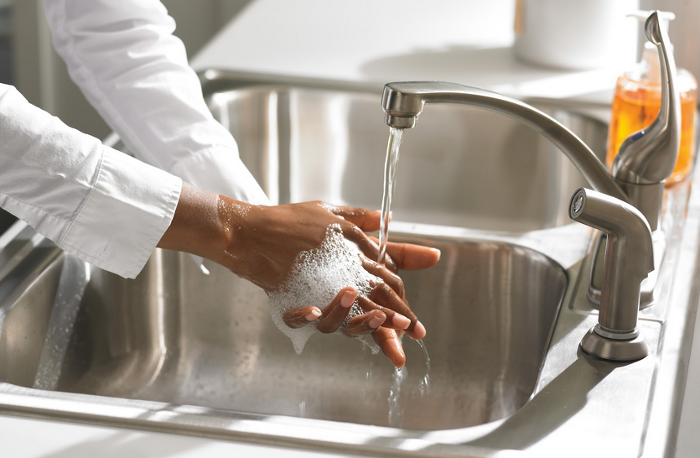Food Handling
The food industry has never been as big as it is now which is why there is greater importance on hygienic food handling whether storing, transporting or disposal.

To get us started on the subject let’s look at the four principles to remember when handling food, they are:
Make sure hands and surfaces are clean before handling food
Wash hands and surfaces often. Bacteria are easily spread throughout catering environments and will get onto hands, cutting boards, counter tops, utensils and of course food.
The best way to reduce the risk of spreading bacteria is to:
- Wash your hands in warm soapy water before and after handling food, using the toilet or anything else that could potential cause germs and bacteria to be spread. Wash your hands for at least 20 seconds.
- Make sure you wash your boards, dishes, utensils, counter tops and anything else you will be using before preparing food.
- When cleaning your kitchen surfaces it may be worth using paper towels, if you do use cloth towels please make sure that these are washed regularly and on a hot temperature.
- Always rinse fresh fruits and vegetables under running tap water, yes even those with skins or rinds which aren’t eaten.
Keep Food Separate
Cross-contamination is an easy way for bacteria to be spread. To ensure that this doesn’t happen make sure:
When you are handling any raw meat, poultry, seafood or eggs make sure that you keep them and their juices away from ready-to-eat food. Also make sure that you are starting preparation with a clean working surface.
Make sure that you store and transport raw meat, poultry, seafood and eggs separately.
When you are using a cutting board make sure that you use a separate one for each ingredient, this is the most common cause of cross-contamination.
Never place cooked meat onto a dish or surface that has previously held raw meat, poultry, seafood or eggs.
Cooking Food Safely
Food is considered safely cooked when it has reached a high enough temperature to kill the harmful bacteria which causes foodborne illness.
Using a food thermometer is the best way to measure the internal temperature of cooked meat, poultry, and also egg dishes to make sure that it is cooked to a safe temperature
Make sure there are no cold spots in food when cooking in a microwave oven; this is where bacteria can survive. The best way to avoid this is to cover the food, stir and rotate during cooking.
When cooking meats; roasts and steaks should cook to a minimum of 145 F, Poultry at 165 F, you can check both with a thermometer.
Eggs should be cooked until both the yolk and white are firm and not runny.
Fish should be cooked to 145 F until the flesh is opaque and separates easily with a fork.
Chilling Food
When it comes to refrigerating foods, the quicker you do this the better; this is because cold temperatures slow the growth of bacteria. But there are a few things to remember whilst you do:
Never let raw meat, poultry, eggs, cooked food or freshly cut fruits or vegetables sit at room temperature for more than 2 hours before putting them in the refrigerator or freezer.
Never defrost food at room temperature, it must be kept at a safe temperature, you can defrost safely the following ways:
- In the fridge
- In cold water
- In the microwave.
Any food that has been defrosted in cold water or the microwave should be cooked immediately.
Now we know the basics, so let’s delve a bit deeper into what we can do to make sure we are safely handling food.
Transportation Of Food
When transporting foods it’s important that they are kept secure and at the right temperature, otherwise you could end up with spoiled goods before they even reach their destination.
- Distribution Containers These are a great way of transporting large quantities of food at a time, particularly useful when in transit in a lorry or van.
- Roll Containers: These are incredibly useful for quick transportation of packaged goods, if there is a jerk or sudden movement which may dislodge the goods then the mess will be contained.
Storing Food
When storing food either in kitchens or walk-in freezer rooms, you need to make sure that meat, vegetables and ready-to-eat foods are kept separately. If you do have limited space then keeping raw foods at the bottom will prevent juices or blood from dripping onto the other foods.
Another thing to keep an eye on will be the temperature. As briefly mentioned, raw meat, poultry and eggs should not be kept at room temperature as this can cause the bacteria to grow and create food-borne illnesses when eventually eaten.
Shelving
When it comes to storing food on shelving your best bet is to use antibacterial shelving. These are ideal for chillers and freezers and can be used in temperatures ranging from -29 c to 88 c. The antibacterial finish means that chance of germs or bacteria developing are massively reduced.
Bins & Trays
Once the food has been delivered it is usually stored in chillers and freezers or a range of food grade bins and containers. These help stop contamination and are usually used for ingredients in places like industrial bakeries and food processing factories.
- Food Grade Tapered Trucks: These are ideal for catering, commercial and industrial settings. They have been used both to transport food and also to serve large quantities of food. They increase manoeuvrability and reduce the amount of manual labour needed.
- Food Grade Round Bins: Specially made for the food industry these bins are made from food-grade polyethylene and offers the maximum storage capacity possible with its straight sided shape.
PVC Curtains
A good investment when you are storing food is especially in chillers and freezer zones.
They not only help to regulate temperature by keeping the cold in and the heat out, but also help to stop insects from entering the storage areas which is another big cause of contamination and the spreading of bacteria.
Preparation of Food
The surface you work on is another main priority when you are preparing food. You need to make sure there are no scratches of crevices on the surface where bacteria could get caught and grow.
A great surface for this is stainless steel benches it’s used commonly throughout the food industry as well as labs for its high hygiene rating and the ease of which you can clean and maintain it.
Serving Food
Once the food has been correctly and safely prepared it needs to be served! A lot of companies use shelf trolleys; now while you may usually associate these with mail or documents, you can get catering trolleys which are specifically designed to transport food. This can be anything from transporting food to another building or delivering sandwiches around the office.
Waste/Recycling of Food
When disposing of any unwanted food waste there are a few options.
- Recycling Waste Bins: For smaller businesses that deal with food on a daily basis, these recycling waste bins are ideal for throwing away waste food. Keeping your work area clear whilst you are preparing food will help to keep your hygiene standards high.
- Steel sack holders: These bins are ideal for food processing factories where waste needs to be dealt with quickly; the foot pedal means that there is no need to touch then bin and is easy for dropping waste in, minimising spillage.
Other Points On Food Handling
Lastly, another thing you should consider is that in the event of an injury, blood will contaminate any food that it lands on. There are a few precautions you can take as well, to make sure you are prepared for any event.
You should have the following in the vicinity:
Of course, this is just a guideline to food handling safety and you can find out more on the subject by heading over to the Food Standards Agency website.

Author Bio - Laura Holland
Social Media and Web Content Coordinator, Jan 2014 - May 2015




